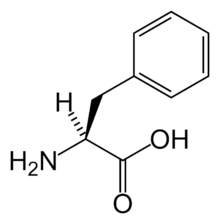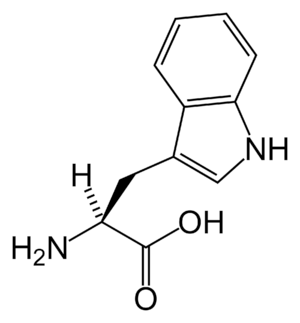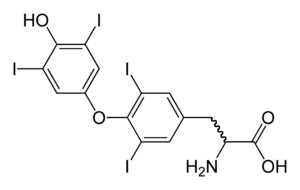Aromatic amino acid
An aromatic amino acid (AAA)[1] is an amino acid that includes an aromatic ring.
Examples include:
- Among 20 standard amino acids:
- Others:
Phenylalanine → Tyrosine → L-DOPA → (Dopamine) → (Norepinephrine) → (Epinephrine)
Tryptophan → 5-hydroxytryptophan → (Serotonin)
Phenylalanine → Tyrosine → Thyroxine
Phenylalanine, tryptophan, and histidine are essential amino acids for animals. Since they are not synthesized in the human body, they must be derived from the diet. Tyrosine is semi-essential; it can be synthesized, but only from phenylalanine. A lack of the enzyme phenylalanine hydroxylase, used in tyrosine synthesis, causes phenylketonuria and concurrently renders tyrosine an essential amino acid.
Aromatic amino acids are able to absorb light due to their conjugated double bonds. This characteristic of aromatic amino acids is used to quantify the concentration of proteins in an unknown sample. These amino acids are able to absorb light which excites its electron to the excited state. When the electron falls back to its ground state, it will either emit light or release energy. If the molecule is able to emit light it is known as a fluorescent molecule. Tryptophan is widely used as a fluorescent molecule.[2]
Animals obtain aromatic amino acids from their diet, but all plants and micro-organisms must synthesize their aromatic amino acids through the metabolically costly shikimate pathway in order to make them.
In plants, the shikimate pathway first leads to the formation of chorismate, which is the precursor of phenylalanine, tyrosine, and tryptophan. These aromatic amino acids are the derivatives of many secondary metabolites, all essential to a plant's biological functions, such as the hormones salicylate and auxin. This pathway contains enzymes that can be regulated by inhibitors, which can cease the production of chorismate, and ultimately the organism's biological functions. Herbicides and antibiotics work by inhibiting these enzymes involved in the biosynthesis of aromatic amino acids, thereby rendering them toxic to plants.[3]
See also
References
- ↑ Logan, Carolynn M.; Rice, M. Katherine (1987). Logan's Medical and Scientific Abbreviations. Philadelphia: J. B. Lippincott Company. p. 3. ISBN 0-397-54589-4.
- ↑ Möller, Matías; Denicola, Ana (2002-05-01). "Protein tryptophan accessibility studied by fluorescence quenching". Biochemistry and Molecular Biology Education. 30 (3): 175–178. doi:10.1002/bmb.2002.494030030035. ISSN 1539-3429.
- ↑ Tzin, Vered; Galili, Gad (2010-05-17). "The Biosynthetic Pathways for Shikimate and Aromatic Amino Acids in Arabidopsis thaliana". The Arabidopsis Book / American Society of Plant Biologists. 8. doi:10.1199/tab.0132. ISSN 1543-8120. PMC 3244902. PMID 22303258.
Further reading
- Maeda, H.; Dudareva, N. (2012). "The Shikimate Pathway and Aromatic Amino Acid Biosynthesis in Plants". Annual Review of Plant Biology. 63: 73–105. doi:10.1146/annurev-arplant-042811-105439. PMID 22554242.
External links

- Aromatic+Amino+Acids at the US National Library of Medicine Medical Subject Headings (MeSH)




.svg.png)